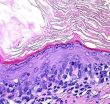(Press-News.org) Scientists have used computer simulations to show how bacteria are able to destroy antibiotics – a breakthrough which will help develop drugs which can effectively tackle infections in the future.
Researchers at the University of Bristol focused on the role of enzymes in the bacteria, which split the structure of the antibiotic and stop it working, making the bacteria resistant.
The new findings, published in Chemical Communications, show that it's possible to test how enzymes react to certain antibiotics.
It's hoped this insight will help scientists to develop new antibiotics with a much lower risk of resistance, and to choose the best medicines for specific outbreaks.
Using a Nobel Prize-winning technique called QM/MM - quantum mechanics/molecular mechanics simulations – the Bristol research team were able to gain a molecular-level insight into how enzymes called 'beta-lactamases' react to antibiotics.
Researchers specifically want to understand the growing resistance to carbapenems, which are known as the 'last resort' antibiotics for many bacterial infections and super bugs such as E. coli.
Resistance to carbapenems makes some bacterial infections untreatable, resulting in minor infections becoming very dangerous and potentially deadly.
The QM/MM simulations revealed that the most important step in the whole process is when the enzyme 'spits out' the broken down antibiotic. If this happens quickly, then the enzyme is able to go on chewing up antibiotics and the bacterium is resistant. If it happens slowly, then the enzyme gets 'clogged up' and can't break down any more antibiotics, so the bacterium is more likely to die.
The rate of this 'spitting out' depends on the height of the energy barrier for the reaction - if the barrier is high, it happens slowly; if it's low, it happens much more quickly.
Professor Adrian Mulholland, from Bristol University's School of Chemistry, said: "We've shown that we can use computer simulations to identify which enzymes break down and spit out carbapenems quickly and those that do it only slowly.
"This means that these simulations can be used in future to test enzymes and predict and understand resistance. We hope that this will identify how they act against different drugs – a useful tool in developing new antibiotics and helping to choose which drugs might be best for treating a particular outbreak."
INFORMATION:
The research was funded by the Engineering and Physical Sciences Research Council (EPSRC).
Paper
'QM/MM Simulations as an Assay for Carbapenemase Activity in Class A β-Lactamases' by Ewa I. Chudyk, Michael A. L. Limb, Charlotte Jones, James Spencer, Marc W.
van der Kamp and Adrian J. Mulholland in Chemical Communications.
Using computers to understand biological catalysts (the QM/MM technique)
Computer simulations provide a way to 'see' a chemical reaction taking place in the heart of the complex protein structure of an enzyme, showing the subtle atomic details of biochemical reactions, using the molecular simulation methods developed by the winners of the 2013 Nobel Prize in Chemistry, Martin Karplus, Michael Levitt and Arieh Warshel.
For further information, please see: http://www.bristol.ac.uk/chemistry/news/2013/172.html
About EPSRC
The Engineering and Physical Sciences Research Council (EPSRC) is the UK's main agency for funding research in engineering and physical sciences. EPSRC invests around £800m a year in research and postgraduate training to help the nation handle the next generation of technological change. The areas covered range from information technology to structural engineering, and mathematics to materials science. This research forms the basis for future economic development in the UK and improvements for everyone's health, lifestyle and culture. EPSRC works alongside other Research Councils with responsibility for other areas of research. The Research Councils work collectively on issues of common concern via Research Councils UK.
The daily trimming of fingernails and toenails to make them more aesthetically pleasing could be detrimental and potentially lead to serious nail conditions. The research, carried out by experts in the School of Veterinary Medicine and Science at The University of Nottingham, will also improve our understanding of disease in the hooves of farm animals and horses.
Dr Cyril Rauch, a physicist and applied mathematician, together with his PhD Student Mohammed Cherkaoui-Rbati, devised equations to identify the physical laws that govern nail growth, and used them to throw ...
This news release is available in German. To date, antidotes exist for only a very few drugs. When treating overdoses, doctors are often limited to supportive therapy such as induced vomiting. Treatment is especially difficult if there is a combination of drugs involved. So what can be done if a child is playing and accidentally swallows his grandmother's pills? ETH professor Jean-Christophe Leroux from the Institute of Pharmaceutical Sciences at ETH Zurich wanted to find an answer to this question. "The task was to develop an agent that could eliminate many different ...
Its central finding is that our nervous system uses past visual experiences to predict how blurred objects would look in sharp detail.
"In our study we are dealing with the question of why we believe that we see the world uniformly detailed," says Dr. Arvid Herwig from the Neuro-Cognitive Psychology research group of the Faculty of Psychology and Sports Science. The group is also affiliated to the Cluster of Excellence Cognitive Interaction Technology (CITEC) of Bielefeld University and is led by Professor Dr. Werner X. Schneider.
Only the fovea, the central area of ...
People who have suffered spinal cord injuries are often susceptible to bladder infections, and those infections can cause kidney damage and even death.
New UCLA research may go a long way toward solving the problem. A team of scientists studied 10 paralyzed rats that were trained daily for six weeks with epidural stimulation of the spinal cord and five rats that were untrained and did not receive the stimulation. They found that training and epidural stimulation enabled the rats to empty their bladders more fully and in a timelier manner.
The study was published in ...
In a first step toward future human therapies, researchers at The Saban Research Institute of Children's Hospital Los Angeles have shown that esophageal tissue can be grown in vivo from both human and mouse cells. The study has been published online in the journal Tissue Engineering, Part A.
The tissue-engineered esophagus formed on a relatively simple biodegradable scaffold after the researchers transplanted mouse and human organ-specific stem/progenitor cells into a murine model, according to principal investigator Tracy C. Grikscheit, MD, of the Developmental Biology ...
LOS ANGELES (Oct. 16, 2014) – Male and female brains are not equal when it comes to the biological response to a high-fat diet. Cedars-Sinai Diabetes and Obesity Research Institute scientist Deborah Clegg, PhD, and a team of international investigators found that the brains of male laboratory mice exposed to the same high-fat diet as their female counterparts developed brain inflammation and heart disease that were not seen in the females.
"For the first time, we have identified remarkable differences in the sexes when it comes to how the body responds to high-fat ...
New research into a rare pathogen has shown how a unique evolutionary trait allows it to infect even the healthiest of hosts through a smart solution to the body's immune response against it.
Scientists at the University of Birmingham have explained how a particular strain of a fungus, Cryptococcus gattii, responds to the human immune response and triggers a 'division of labour' in its invading cells, which can lead to life-threatening infections.
Once inhaled, the pathogen can spread through the body to cause pneumonia or meningitis. The outbreak strain of this fungus ...
(Vienna, October 17, 2014) Two new pill-only regimens that rapidly cure most patients with genotype 1 hepatitis C (HCV) infection could soon be widely prescribed across Europe. Two recently-published studies1,2 confirmed the efficacy and safety of combination therapy with two oral direct-acting antiviral agents (DAAs), with around 90% of patients cured after just 12-weeks of treatment.
At the 22nd United European Gastroenterology Week (UEG Week 2014) in Vienna, Austria, Professor Michael P. Manns from Hannover Medical School in Germany will be presenting this data and ...
A group of researchers led by Melina Bersten of the Kavli Institute for the Physics and Mathematics of the Universe recently presented a model that provides the first characterization of the progenitor for a hydrogen-deficient supernova. Their model predicts that a bright hot star, which is the binary companion to an exploding object, remains after the explosion. To verify their theory, the group secured observation time with the Hubble Space Telescope (HST) to search for such a remaining star. Their findings, which are reported in the October 2014 issue of The Astronomical ...
Peering through a giant cosmic magnifying glass, NASA's Hubble Space Telescope has spotted a tiny, faint galaxy -- one of the farthest galaxies ever seen. The diminutive object is estimated to be more than 13 billion light-years away.
This galaxy offers a peek back to the very early formative years of the universe and may just be the tip of the iceberg.
"This galaxy is an example of what is suspected to be an abundant, underlying population of extremely small, faint objects that existed about 500 million years after the big bang, the beginning of the universe," explained ...





